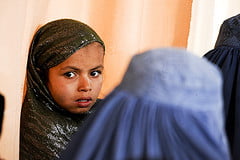NEW HAVEN, Connecticut – Taliban leaders are prepared to drop their opposition to girls’ education, Afghan education minister Farooq Wardak told Jon Boone of the Guardian.
Before anyone gets excited, it’s important to remember three things about the Taliban’s record on this issue:
1) During their time in power, the Taliban phrased their opposition to girls’ education as opposition to co-education, secular education of girls, education of girls in wartime, and education of girls past puberty. In practice, these policies translated to a near-total ban on female education until 2002, but the rhetoric was slightly different than that.
2) The Taliban have always made some meager exceptions.
A veteran aid worker interviewed by the Guardian explained that 33,000 girls (a tiny fraction of all school-age girls in a young country of more than 20 million people) were able to attend school under the Taliban regime:
“It was a sort of hidden policy,” [Swedish Committee for Afghanistan education expert] Amir Mansory said. “No one said girls could go to school, but in the provinces Taliban officials would approach me asking for the Swedish Committee’s help in supporting girls’ schools.”
And while insurgents have closed down many schools around the country in recent years, Mansory said they have been actively supported in some Taliban-controlled areas, including in Paktika and Wardak provinces.
Even when they ruled Afghanistan, the Taliban took a haphazard, though broadly hostile, approach to the education of women and girls. Mansory’s organization was quietly allowed to operate some schools. Many other NGOs weren’t so lucky. According to a 1999 Amnesty International report:
Some initiatives have been taken to get around the Taleban ban by setting up home-based schools for girls. These have been supported by the UN and international non-governmental organisations and operate in some Taleban-controlled areas. However, in Kabul, home-based schools along with vocational training programmes for women were closed by the Taleban administration in June 1998. The head of the Department for the Promotion of Virtue and Prevention of Vice (DPVPV) accused the schools of spreading anti-Taleban propaganda.
3) The Guardian article states that, “Public acceptance of female education by the Taliban would be seen as a milestone, particularly by western nations anxious that any peace deal does not undermine the rights of women.”
It’s not at all clear what “acceptance” means in this context. Acceptance of education for teenage girls and adult women? Acceptance of women in co-educational universities? Would the Taliban accept the presence of girls in schools that operate in gender-segregated shifts? What about schools that segregate classrooms but allow boys and girls to attend at the same time?
Bottom line: Wardak’s statements should be treated with caution. The Taliban might be willing accept current education policies. (Alex Strick van Linschoten, a leading expert on the Taliban movement, thinks that’s the case.) Or they might be willing to allow girls to attend school only as young children, under education-crippling conditions. Or they might be trying to pass off their old position on girls’ education as a sea change in thinking to internationals with little knowledge of Afghan history before late 2001. Until actual talks begin, or the Taliban leadership in Quetta issues a clear public statement on the matter, we can’t really know.
Update: Via Twitter, Alex tells me, “I never said I thought we’ve seen a total reversal on Taliban education policies. My comments I made to guardian were not printed in full (obv). I didn’t think Wardak’s comments actually mean all that much.” So, even more reason for skepticism here.
